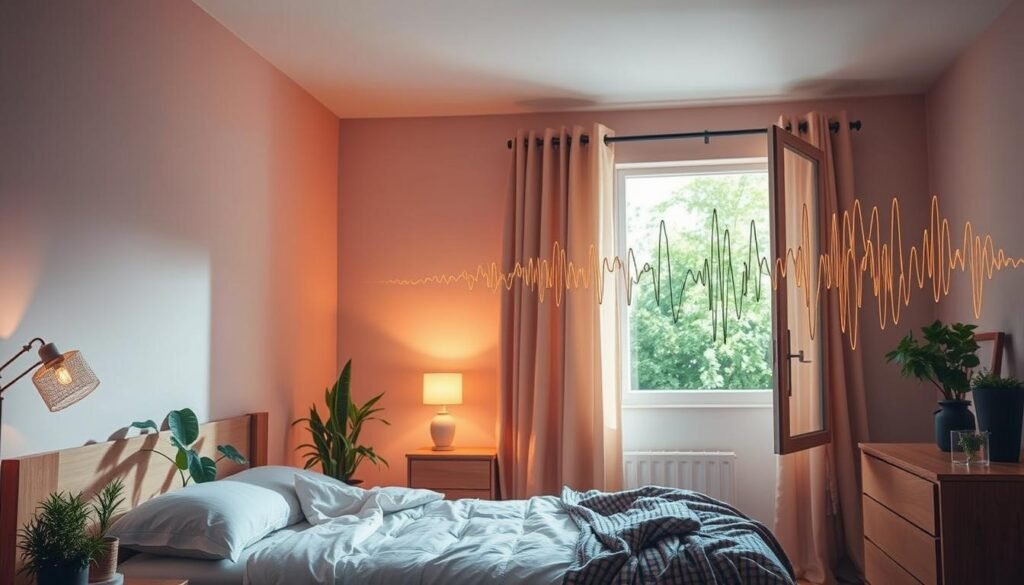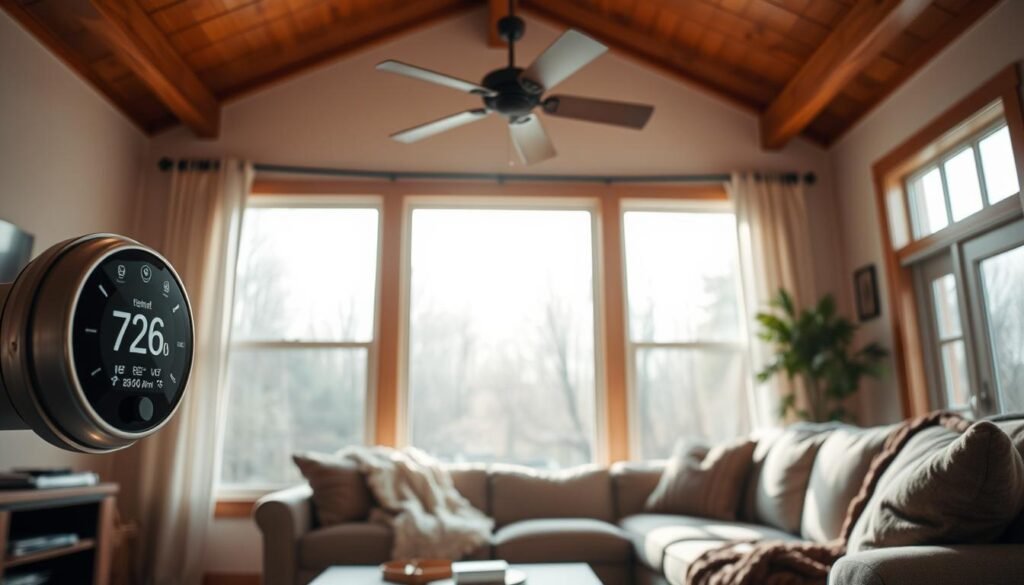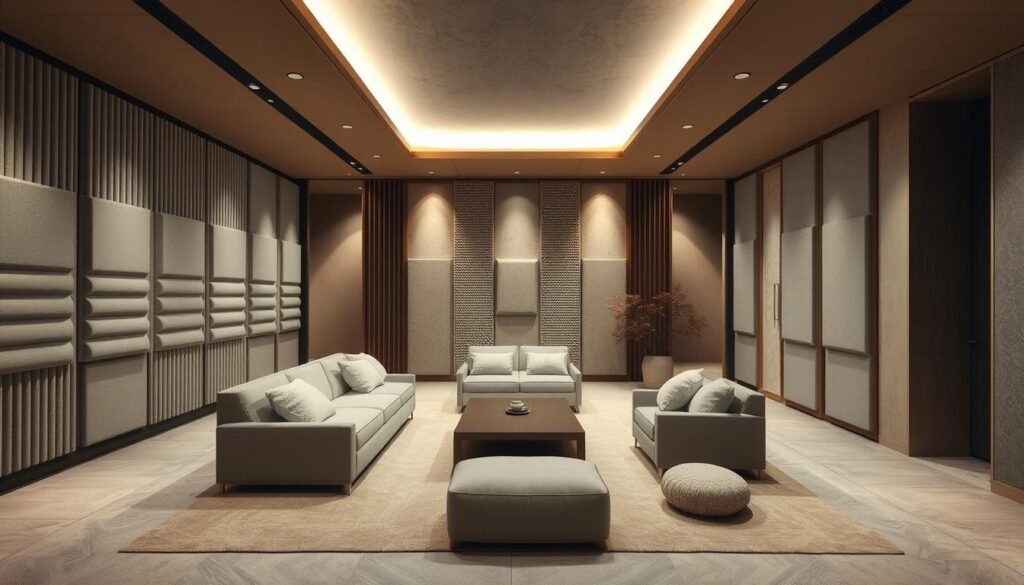Did you know the best room temperature for sleep is between 60 and 67 degrees Fahrenheit? This range is not just good for sleep but also for making indoors comfy. Getting the right mix of temperature, light, and noise can make our daily lives and health better. In this article, you’ll learn how these factors work together to create the perfect space for you.
Key Takeaways
- The ideal sleep temperature ranges from 60 to 67 degrees Fahrenheit for better sleep quality.
- Personal preferences can vary; testing different options is key to achieving optimal comfort.
- Minimizing noise enhances deep sleep and reduces nighttime awakenings.
- Natural light exposure during the day aids in regulating circadian rhythms.
- Effective noise reduction strategies include white noise machines and soundproofing solutions.
- A thoughtful arrangement of lighting can improve mood and overall indoor ambiance.
- Regular maintenance, such as washing sheets and pillowcases, contributes to a clean and restful environment.
The Importance of Room Temperature
Room temperature is key to a comfortable and productive setting. It’s vital to understand thermal comfort. This means feeling just right in your thermal environment. Knowing how to manage the warmth or coolness indoors helps optimize spaces for activities like chilling and sleeping.
Understanding Thermal Comfort
Thermal comfort deeply impacts our well-being. For better sleep, a room at about 65 degrees Fahrenheit is ideal. It helps our bodies cool down for restful sleep. Different activities need different temperatures. For example, working out might require cooler conditions. Relaxation spaces, however, may need to be a bit warmer. Here’s more on managing indoor climates.
Ideal Temperatures for Different Activities
Keeping the right temperature is crucial for comfort and productivity. Here are some ideal temperature ranges for various activities:
| Activity | Ideal Temperature (°F) |
|---|---|
| Sleeping | 65 – 68 |
| Exercising | 60 – 65 |
| Relaxing | 68 – 72 |
| Working | 70 – 75 |
Selecting the correct temperature for each activity boosts performance and happiness. Always mix these tips with your own comfort preferences for the top outcomes.
Lighting and Its Role in Indoor Environments
Lighting is key in shaping indoor environments, impacting mood and work efficiency. Natural light boosts mood and well-being by raising serotonin in the brain. It’s best to use natural light when we can. But, we also need to think carefully about artificial lighting. How we mix natural and artificial light affects a room’s feel and use.
Influence of Natural Light on Mood
Natural light makes rooms brighter and improves mood. Sun exposure boosts mental health and keeps our body’s clock in check. This helps us stay energetic all day. Using windows and skylights in buildings captures this natural light.
Types of Artificial Lighting
Selecting the correct artificial lighting is vital for setting the right mood. There are different types:
- Incandescent bulbs: They have a warm glow, making spaces cozy but use more energy.
- Fluorescent lighting: Common in offices, this lighting saves energy and lasts long but might strain the eyes.
- LED lights: Offer bright light, save energy, and come in various colors, fitting many needs.
Different lighting styles, like task, ambient, and accent lighting, have unique roles. Task lighting increases visibility for work. Ambient lighting brings comfort to spaces. Choosing the right lights affects energy consumption and how we feel. Knowing how artificial lighting affects our brain can better our focus and relaxation. For more on lighting’s effect on indoor spaces, check out this study.
| Lighting Type | Characteristics | Energy Efficiency |
|---|---|---|
| Incandescent | Warm light, cozy atmosphere | Low |
| Fluorescent | Bright, cool light | Medium |
| LED | Bright, available in multiple temperatures | High |
Room Temperature, Lighting, and Noise: An Interconnected Balance
Creating a great indoor space means understanding how temperature, lighting, and noise connect. Each factor influences the other, affecting comfort and work quality. Studies show the best office temperature is between 68 and 76 degrees Fahrenheit.
Being too cold at work can increase mistakes. It might even hike up labor costs by 10% due to lack of focus. When it’s too hot, above 80 degrees, manual work slows down by up to 4%. High heat harms our ability to remember and pay attention, which is key for doing a good job.
Noise matters too; it can make temperature problems worse. The right balance is crucial. Too hot, and we get tired and dehydrated. Too cold, and our hands might go numb.
So, a perfect indoor space needs good temperature, lighting, and quiet. This mix helps us feel good and do our best work.
The Ideal Room Temperature for Sleep
Having the right room temperature for sleep is key. Studies show that keeping your bedroom between 60 to 67 degrees Fahrenheit helps you sleep better. If the temperature goes beyond this range, your sleep might suffer. It’s important to follow these temperature guidelines at night.
Scientific Recommendations for Nighttime Temperature
Sleep experts like Michelle Drerup suggest a bedroom temperature of 60 to 67° F for adults. This range helps you sleep well and keeps your REM sleep steady. If your room is hotter than 70° F, you might feel restless. And if it’s colder than 60° F, it could be bad for your health. For young kids, a warmer room of 65 to 70° F is better for their growth.
How Temperature Affects Sleep Quality
Sleep and temperature are closely linked. A cooler room helps make more melatonin, which you need to fall asleep. But, too much heat can hurt your sleep quality. It can affect your emotions and how well you think. You can use cool sheets and fans or air conditioning to keep your room comfortable.
By sticking to these temperature tips, you can enjoy deeper sleep. This leads to better health and daily life. Knowing how room temperature changes your sleep is important. It helps you create better sleep habits and places to sleep.
Lighting Levels: What’s Right for You?
It’s key to know the right light levels for comfort and efficiency. The right amount of light depends on what you’re doing. Whether you’re studying, working, or chilling out, the right lighting can make a big difference.
Understanding Illumination Levels
Illuminance is measured in lux. Different places need different levels of light. For example, a living room may need 100-150 lux. A kitchen usually needs more, about 250-300 lux. Classrooms and libraries need even more light, around 300-500 lux and 500 lux, respectively. The right light level can boost productivity and mood.
Impact of Brightness on Circadian Rhythms
Brightness affects our circadian rhythms, which help us sleep well. Too much light at night can make it hard to sleep. It’s good to limit bright light at night. This can help you sleep better and feel better overall. You should also be able to adjust your light to fit your needs and tasks.
Noise Pollution and Its Effects on Health
Noise pollution greatly affects our well-being, especially where we live. This unwanted noise can cause stress and disturb our sleep. It’s important to deal with these noise sources for a healthier living space.
How Noise Disrupts Sleep
Noise really messes with our sleep. Studies have found that loud sounds at night link to poor sleep. People end up resting badly, which can make health issues worse.
Long-term noise can lead to serious problems like heart disease and hearing loss. Noise above 85 dB might permanently harm our hearing if we’re exposed too long. Loud sounds at night make our sleep quality drop.
Common Sources of Noise in Home Environments
In our homes, noise often comes from appliances, entertainment systems, and outside like traffic or construction. Construction sounds can be as loud as 105 dB, which is really disruptive. Knowing these sources helps us find ways to reduce their impact, like soundproofing or changing our room setup, improving our comfort and health.

For more information about how noise affects our health, check out this resource.
Creating a Comfortable Atmosphere
Making a comfy space is about focusing on how the area is set up. It means picking furniture and fabrics that invite people in. Achieving a mix of function and ease is key to the room’s feel.
Designing Your Space for Comfort
Designing for comfort means adding features that make a space cozy. Here’s how:
- Place furniture so that it’s easy to move and talk.
- Choose chairs and desks that keep you sitting right.
- Add natural materials for a calm look.
- Ensure good air flow for better health.
With these steps, you can create a peaceful place that makes you feel good. It’s about bringing balance and harmony.
The Role of Colors and Decor in Ambiance
Colors deeply affect how a room feels. Soft blues and greens spread calm, while bright yellows bring energy. Keep in mind:
- Select colors that you love for a restful background.
- Use decorations that show your personal taste, making the space unique.
- Add comfy textiles and accessories for extra warmth.
Blending these elements together helps make a spot that’s not just pretty but also a retreat for getting things done and chilling out.
Tips for Managing Room Temperature
Keeping the right temperature inside is key to being comfy. Changing things up with the seasons can make a big difference in feeling good and saving on bills. Learn the right way to use fans and heaters to keep your space just right all year.
Seasonal Adjustments
When it gets hot, fans are great for keeping cool and cutting down on AC use. This not only keeps you comfortable but also helps with saving energy. Then, when it’s cold, you can use heaters smartly. This means you stay warm without using too much power.
It’s smarter to keep things a bit cooler in the winter. You can wear extra clothes to stay warm. This approach stops the place from getting too hot.
Using Fans and Heaters Effectively
Getting the most out of fans and heaters means thinking about how you use them. With programmable thermostats, you can set temperatures that save energy. For example, lower the heat at night or when no one’s there. This smart move saves power and money.
Consider ductless mini-split systems for specific area heating or cooling. They use energy only where it’s needed. Smart fans, like the SmartCocoon, work well with your existing heating and cooling. They keep you comfy and help save energy, too.

Lighting Techniques for Better Relaxation
Creating a relaxing environment starts with choosing the right lighting. In the evenings, soft lighting is key for calmness. It helps you unwind and get ready for sleep. Using ambient lighting fixtures makes any room warm and inviting.
Soft Lighting Ideas for Evening Use
Selecting soft lighting for the evenings is crucial for a peaceful space. Here are some good ideas:
- Table lamps with dimmable features let you adjust the brightness.
- Floor lamps with warm bulbs make great spots for reading or meditation.
- String lights add a cozy feel without being too bright.
- Smart bulbs adjust in brightness and color, perfect for relaxation.
Lighting Fixtures that Enhance Ambiance
When picking ambient lighting fixtures, focus on flexibility and style. Use ceiling mounts or wall sconces as options.
| Fixture Type | Benefits |
|---|---|
| Smart LED Bulbs | They let you change brightness and color to improve mood and sleep. |
| Dimmers | They allow custom light levels for different activities. |
| Decorative Lamps | They add beauty while offering soft lighting. |
| Recessed Lighting | These provide a modern look and softly light up areas. |
Add these elements to boost your home’s evening ambiance. For better relaxation, try different breathing exercises along with good lighting.
Acoustics: Designing for Quiet
Creating a quiet space is all about good sound management. It’s important to use soundproofing to keep spaces silent. This way, you can avoid annoying background noise and feel more at ease.
Soundproofing Techniques for Optimal Silence
Soundproofing is key in places like offices and classrooms. There are many ways to keep out unwanted noise. Doing this can stop distractions that hurt our focus and comfort.
- Position teaming spaces away from busy corridors.
- Incorporate acoustical ceilings with a noise reduction coefficient (NRC) of 0.75.
- Utilize systems furniture with a height of 60 inches.
- Set aside specific rooms for printers and copiers.

Using Background Noise Creatively
Some people find benefits in certain types of background noise. White noise machines or gentle music can mask distracting sounds. This can help you focus better or relax more.
Designing spaces smartly can block out external noise. For example, classrooms away from roads are quieter. Using windows with multiple panes also helps keep a place calm.
| Technique | Benefit |
|---|---|
| Acoustical ceilings (NRC 0.75) | Minimizes sound reflection |
| Insulated wall partitions | Reduces noise transfer |
| False ceilings with acoustic tiles | Improves internal noise reduction |
| Rubber feet on furniture | Decreases impact noise |
| Use of curtains and porous materials | Enhances sound absorption |
Using these soundproofing strategies makes places peaceful. It helps everyone feel more comfortable and happy. A smart approach to acoustics keeps spaces quiet, boosting productivity and well-being.
The Role of Technology in Enhancing Comfort
Technology plays a big role in making our homes comfier. It lets us control the climate and lights just how we like. Thanks to smart gadgets, tailoring our living spaces for comfort is easy. We now have smart thermostats and lighting systems changing the way we live indoors.
Smart Thermostats for Perfect Temperature Control
Smart thermostats make managing home temperatures easy. They let people set up heating and cooling to work automatically. The National Sleep Foundation suggests keeping bedrooms at 67 degrees Fahrenheit for good sleep. Smart thermostats do this with ease, adjusting as needed or based on our routines. They even work in places like retirement homes to keep everyone comfortable.
Light Control with Smart Lighting Solutions
Smart lighting systems change the game for ambiance and saving energy. They adjust the light based on what we want or the sunlight available. With smart window shades and bulbs that change colors, creating the perfect mood is simple. Adding technology to lighting can even help us sleep better and stay healthier.
| Device | Functionality | Benefits |
|---|---|---|
| Smart Thermostat | Automated temperature adjustments | Enhances comfort, saves energy |
| Smart Lighting | Adjustable lighting settings | Improves ambiance and mood |
| Sleep Tracker | Monitors sleep patterns | Provides feedback for better sleep |
| Smart Mattress | Adjusts firmness and temperature | Enhances comfort for better sleep |
Conclusion
To create a great indoor space, it’s important to balance temperature, lighting, and noise. Changing these can make places better for work and life. For example, loud noises can lower work quality. But, light levels don’t change much.
Using smart devices for heat and light lets people set up what works best for them. This article shows how good design improves comfort and health. It also shows how sound, sight, and temperature work together to make environments better.
By using these ideas, people can make spaces that fit their way of living. Paying attention to sound, light, and heat helps make places more enjoyable and work-friendly. So, making your space comfy is more than just making small changes. It’s about creating a healthy, productive place.